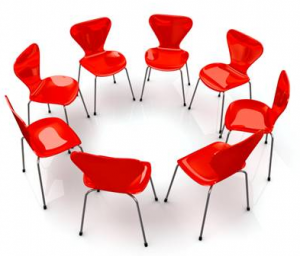 We gathered in concentric circles, like the rings on a tree that show its age, in a small community hall this week, to sing songs that celebrated our friend, who had just died. With those in the innermost circle leading the songs, we sang together, folk favourites of the deceased. Combined with other remembrances, food, and conversation, it made for a rich and moving time.
We gathered in concentric circles, like the rings on a tree that show its age, in a small community hall this week, to sing songs that celebrated our friend, who had just died. With those in the innermost circle leading the songs, we sang together, folk favourites of the deceased. Combined with other remembrances, food, and conversation, it made for a rich and moving time.
Song circles, like the one for my friend, acknowledge the power of the circle, as a process, a way for community to come together, support one another, and connect to one another.
The ritual of, and respect for, the circle goes back to our cave dwelling days, sitting around the fire. I’m often surprised we don’t apply the circle more, in our work, as a way to solve problems, build relationships, and more.
Sitting around a table, in a local watering hole, a few days ago, with 8 other local dispute resolution professionals, the topic of circles galvanized our attention. Especially, after one of my mediation colleagues told us about some of the organizational work he was doing, assisting employees who routinely work in high-stress occupations. Through 3-day circle workshops, with chairs arranged in a circle, sans tables, a dozen individuals would each share those events that had shaped their life, and once done, relate those events to the way they dealt with current problems and challenges. Listening to stories, gaining insight into motivations, and collaborating on strategies, all done, building on the circle process.
People are continually looking for new ways to problem-solve. Maybe it’s the old ways that need to be given their due, again? And maybe we are coming around more to the value of those old ways. Maybe we are breathing life into something we thought was dead?
For many of us, sitting in a circle, without anything between you and the others, can make us uncomfortable, at least initially. Yet, when I observe circles being used in restorative justice, workplace conflict, in schools, in community reconciliation� I feel uplifted. Could we be trending, here?
Being together in circles is re-connecting with tradition, and what’s more, connecting with our inner calling, as social animals. I’m certain the intention of Google to use circles as the basic unit of organizing people, in Google+, is recognition of the power, and evergreen, nature of circles.
How about you? Where do you observe circles making a comeback? And, where would you like to see them used more?
[Leave a comment about this post. Subscribe to the feed to get regular updates.]

Thanks for calling our attention to the power and potential of Circles. I use circles all the time as a facilitator, trainer and consultant. It is the most powerful process I have found, especially for responding to conflict.
Like you, I too am uplifted.
Thanks Ben.
Thanks Ben – I share your enthusiasm for Circles! Like Evelyn, I get to utilize Circles – at St. Croix Valley Restorative Justice Program http://www.scvrjp.org – we use them for Restorative Justice and to address a variety of public health issues. I think geese get the V, and humans get the O! Enjoy your blog!
-Kris
Evelyn, I agree with your take on the circle for conflict resolution. It certainly is an effective way to put everyone on the same plane… as I’m sure you know. Thanks for connecting, here.
Kris, Thanks. I love your V and O take on things… a nice way to remember/highlight what matters… depending on your species! And, I’ve heard good things about your RJ Program in Wisconsin, too. 🙂
Hi Ben
I just stumbled upon this great post. I also posted on circles last week, without knowing that you were on a similar mind path … maybe we are trending!
Here’s the link to my post – http://communitiesknow.com/2011/11/08/change-the-room-change-the-culture/
I look forward to tracking down more writing on ‘circles’.
Thanks Laura. I checked out your post on circles… excellent… left a comment, too. Yes, maybe we are trending… and/or maybe us west coasters are just in tune with the circle power! I know a lot of my respect for circles is connected to, influenced by, the strength of our local, aboriginal cultures.